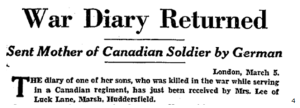Saturday, May 29, 1915
Reserve trenches, Rue de l’Epinette
The Battalion War Diarist wrote for this day: “Quiet except for occasional German shells.”[1]
THIS DAY IN RMR HISTORY: While the Battalion Diary indicated a quiet scene, it was not entirely peaceful. Three soldiers of the Battalion died that day, including Private John Lee, No. 25607.
The Battalion history recounts: “At night on May 28th the enemy attacked the barricade erected by the men of the 14th at L8. Bombing and counter-bombing followed, the attackers achieving not even a measure of success. Later that night when the 14th Battalion was relieved by the 13th Battalion, a working party of 100 men under Lieuts. Dick Worrall and J.H. Richardson, remained to establish a line, previously reconnoitered by Sergt. H.G. Brewer,* between K5 and the Post Office Rifles on the right. Some time after the relief Stretcher Bearer Lee, of the 14th went into No Man’s Land to the assistance of a wounded German who called for help. Reaching the German, Lee fell wounded, whereupon two stretcher bearers of the 13th volunteered to bring him in. These bearers were in turn wounded, but before dawn all the fallen men, including the German, were brought in to the Canadian lines by Capt. W. H. Clark-Kennedy and two stretcher bearers, all of the 13th Battalion. The assistance given to Stretcher Bearer Lee on this occasion was appreciated by the officers and men of the 14th and served to strengthen the comradeship between the Royal Highlanders of Canada and the Royal Montreal Regiment. From the front line, stretcher bearers carried Lee to Indian Village, the ground being so difficult that four hours were taken to cover the few hundred yards. Unfortunately Lee’s wounds were severe and he died after being evacuated from the Battalion Dressing station.” [2]
* Sergt. Hugh Graham Brewer, later earned his commission and was a Major by the time the Battalion returned to Canada. In 1940, shortly after the outbreak of the Second World War, a 2nd (Reserve) Battalion, Royal Montreal Regiment was formed. Major H.G. Brewer was the initial Second-in-Command, and eventually succeeded his predecessor, Lieut.-Col. J.E. McKenna, M.C., as Commanding Officer in 1940, a post he held until November 12, 1945.
PRIVATE JOHN LEE, No. 25607: Private John Lee was born at Huddersfield, Yorkshire, June 21st 1885. Leaving his family behind, he emigrated to Canada, where he worked as a storeman. When war was declared in 1914 he immediately enlisted with the 14th Bn. As described above he sustained gun-shot wounds to his abdomen inflicted by a German sniper while recovering a wounded German soldier on May 28th 1915, and died of his injuries the following day. He is buried in Hinges Military Cemetery, France.
As the war progressed there were few who had not experienced a loss, or were at least close to someone who had. There are numerous examples of families who lost 3, 4 or 5 sons in battle during the war. The Lee family was no exception. John Lee’s younger brother, Private Henry Lee of the Imperial Army Cyclists Corps died of wounds October 20th 1917. Another brother, Sergeant Stephen Hargill Lee, DCM and Bar, 2/5th Duke of Wellington’s Regiment who enlisted on the day war broke out in 1914, was killed on November 7th 1918, age 24, just four days before the Armistice. He had been awarded the DCM for “conspicuous gallantry and devotion to duty”. The trauma for their parents Henry and Ada Lee can only be imagined. Pte. John Lee also left a wife, who with his parents lived in Huddersfield, Yorkshire. [3]
 Twenty years after John Lee’s death, his mother received an unusual message.
Twenty years after John Lee’s death, his mother received an unusual message.
“London, March 5, 1935. The diary of one of her sons, who was killed in the war while serving in a Canadian regiment, has just been received by Mrs. Lee of Luck Lane, Marsh Huddersfield. Mrs. Lee received a postcard a fortnight ago from a man named Hohlstein of Pirmasens, a small town in Bavaria, on which he stated that he wished to forward the diary. She has now received it with this letter: “Dear Mrs. Lee: I found the diary of your son on the 28th or 29th of May 1915, in a house at St. Julien, near Ypres. The Canadian regiment had left the village as we stormed it. The book will be a sad memory for you, especially as you offered your Fatherland your five sons.”
The diary belonged to Mrs. Lee’s second son, John, of the 1st Royal Montreal Regiment, who was wounded on May 28, 1915, and died the following day.” [5]
[1] War Diary, 14th Canadian Battalion, The Royal Montreal Regiment, May 29, 1915. Library and Archives Canada, Ottawa http://data2.collectionscanada.ca/e/e044/e001089734.jpg
[2] R.C. Featherstonhaugh, The Royal Montreal Regiment 14th Battalion C.E.F. 1914-1925, Montreal, The Gazette Printing Co., Ltd., 1927, pg. 60.
[3] J. Margaret Stansfield, “Huddersfield's roll of honour: 1914-1922,” University of Huddersfield Press, Huddersfield, 2014 http://eprints.hud.ac.uk/21278/1/Introduction_FINAL.pdf
[4] “War Diary Returned – Sent Mother of Canadian Soldier by German,” The Globe (1844-1936), Toronto, Ontario, March 6, 1935, pg. 9, col. 1.
[5] Ibid.

